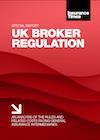Read a free excerpt from the Insurance Times UK Broker Regulation report

Brokers were given a strong reminder of how expensive it is to run an insurance broker in the UK when Biba unveiled its 2014 manifesto.
The manifesto contained research commissioned by the trade body showing that the UK has the most expensive regulatory regime of 23 leading nations around the world, measured by direct costs of regulation as a percentage of income derived from insurance broking.
The research, by policy and economic consultancy London Economics, found that the UK regulatory regime is costing brokers an average of 0.98% of their broking income. This is five times more than brokers are paying in competitor financial centres of New York and Japan, and 14 times the global average.
Brokers are effectively cross-subsidising the costs of supervising banks.”
David Sparkes, Biba
Biba head of compliance and training David Sparkes says: “It is quite staggering. How is that competitive? We are comfortable with a strong regulator that is active in the markets where it needs to be. We don’t see the insurance broker market as an area where they actively need to be and recover their costs from.”
He adds: “As the current funding model stands, brokers are effectively cross-subsidising the costs of supervising banks.”
The figures released by Biba so far only cover the direct cost of regulation, and so excludes costs such as bills for regulatory training and consultancy, salaries for compliance staff, and man hours spent on responding to requests for information and thematic reviews. It expects to reveal the impact of indirect costs later this year.
Brokers surveyed by Insurance Times for this report spent an average of 6.2% of their turnover on compliance under the new FCA regime. This compares with 5.7% under the old FSA regime.
Furthermore, 89% of respondents expect regulatory costs to continue rising.
So what is driving the cost, is it getting higher, and could the expense drive brokers out of the UK or stop them setting up here?
More costly than the FSA
Brokers’ direct regulatory expenses comprise of fees or levies paid to four bodies: the FCA, the Money Advice Service, the Financial Services Compensation Scheme (FSCS) and the Financial Ombudsman Service. The amount a broker pays to these four bodies is based on their annual revenue (see box, bottom left).
To get an idea of how much brokers pay these four bodies, Insurance Times fed the annual revenue details for three hypothetical brokers into the FCA’s fee calculator: a small broker with annual revenue of £250,000, a mid-sized firm with annual revenue of £4m and a large broker with £700m of annual revenue.
The results show that the FCA is costing brokers more than the FSA was. The annual FCA fee for the 2013/14 financial year – the FCA’s first year in power – was higher than the previous year’s FCA fee for all three example brokers.
The small broker has experienced a fee hike of 3.9%, the mid-sized broker 13.2% and the large broker 15%.
But the FCA fee is the least of brokers’ worries. The FSCS levy makes up the lion’s share of all brokers’ regulatory fees. In 2013/14, the FSCS levy made up 52.6% of the hypothetical small broker’s regulatory costs and 72.2% of the large broker’s costs.
This is particularly galling for brokers because the high level of the FSCS levy in recent years has been driven by the mis-selling of payment protection insurance (PPI), which most insurance brokers do not sell.
Carol Nash chief executive David Newman says the FSCS levy is too high and disproportionate.
“As brokers we feel it is unfair the way it has been categorised. Effectively, we are the backstop for claims on PPI,” he says. “It’s a good thing there is a financial backstop for consumers. However, it should be segmented in a way that is fairer to the industries.”
We are getting hit for something we never sold.”
Mark Bower-Dyke, Be Wiser
Be Wiser chairman Mark Bower-Dyke adds: “We are getting hit for something we never sold. The actual cost of being regulated is not overly onerous, but the cost of having to pay for the banks mis-selling of PPI is.”
There is hope for brokers. Insurance broking accounts for 1% of the UK’s gross domestic product and there are signs that brokers’ concerns about the cost of regulation are at least being heard.
Sparkes says: “I don’t see immediate change but the FCA mentioned that it is going to look at this. The FCA appreciates that more than the FSA did. Treasury is conscious of it because we have regular meetings with them.”
London’s advantages
For some brokers at least, the high cost of UK regulation is something they are willing to bear because of what they get in return.
Hyperion chief executive David Howden says: “You have an enormous talent pool in London. You have every insurer worth doing business with based here in some way. You still have Lloyd’s of London here.
“There are many advantages of being headquartered in the UK that possibly outweigh the fact that it is slightly more expensive than elsewhere. We have no intention at all of moving our head office out of here.”
Not all brokers will agree, particularly if the costs continue to rise.
UK BROKER REGULATION REPORT

Insurance Times has created a comprehensive UK Broker Regulation report that brings together everything brokers need to know about the changing regulatory landscape. From preparing for FCA visits to handling client money, dealing with unrated insurers and the implications of thematic reviews and more, this report is required reading for all brokers.
Hosted by comedian and actor Tom Allen, 34 Gold, 23 Silver and 22 Bronze awards were handed out across an amazing 34 categories recognising brilliance and innovation right across the breadth of UK general insurance.









































No comments yet